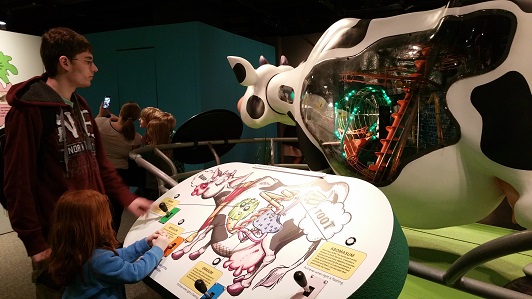 “That’s Disgusting!”
“That’s Disgusting!”
Between shrieks of “Ew, that’s disgusting!” and “Hey, check this out!” the Academy of Natural Science has successfully launched an amazingly engaging and totally gross exhibit for all ages in Animal Grossology.
It is a tough time of year to keep kids engaged in learning, with warmer weather settling in and summer camp plans brewing… insert Grossology, the perfect opportunity to keep your children engaged in learning. With disgusting facts of hairballs, vomit and poo, mixed with awesome animal animatronics… this is sure to be an exhibit talked about for months and definitely a little something for them to share with friends in the lunch room.
“Oozing with disgusting science, Animal Grossology provides a slightly off-kilter view of the animal kingdom at the Academy of Natural Sciences of Drexel University. Get ready to be totally en-GROSS-ed! Based on the best-selling Grossology children’s book series by Sylvia Branzei, Animal Grossology is packed with hands-on fun that celebrates those yucky topics moms warn their kids not to discuss at the dinner table. Animal Grossology offers a fresh take on some of the more disgusting things animals do and engages visitors in how blood, vomit, pellets, dookie, and slime can be fun, funky and even fascinating.”
– Press Release, Academy of Natural Sciences




Many thanks to the Academy of Natural Sciences for the ANIMAL Grossology Trivia below:
* Animals have red, blue, yellow or clear blood. Blood is very nutritious as it contains a lot of protein.
* A cow has one stomach but it is in four parts. A cow’s stomach is equal in size to nine human stomachs.
* Some frogs belch their babies into the world.
* Ticks often relocate by hitching a ride on a migrating bird.
* A Hagfish may be the slimiest creature on earth.
* Tapeworms grow inside the stomach and can grow up to 60 feet-long.
*Animals use smells for recognition, defense and attraction.
* Slime is essential to some animals, providing important functions such as facilitating motion, aiding in digestion and for defense.
* Blood slurpers transmit infectious diseases.
*What is caca, feces, dookie, guano, splay and stool stand for? All are names for “number 2”!
*Sea stars eat by shoving their stomachs out, digests the food and sucking their stomach back in.
* You can identify an animal by its “dookie” sizes, content and shape.
* An animal may feel very different from what you expect, once you have touched them.
* Why do owls purge “pellets”?
* Houseflies taste food using their feet and legs!
AND…
Did you know that copper gives some animals blue blood?
Did you know that flies fly at 4.5 mph?
Did you know that cats use their tongues as natural combs to remove loose hair?
Did you know a cow’s stomach is equal in size to nine human stomachs?
Did you know that shark skin is covered with tiny tooth-like scales called denticles?
Did you know the female mosquito needs a blood meal to lay eggs?
 The Academy of Natural Sciences is located in Philadelphia with weekday hours Monday–Friday, 10 a.m.–4:30 p.m.; and weekend hours of Saturday–Sunday, 10 a.m.–5 p.m. For more information on exhibits, changing exhibits, tools for education and direction please visit their website at www.ansp.org. The Animal Grossology exhibit is showing until August 30th.
The Academy of Natural Sciences is located in Philadelphia with weekday hours Monday–Friday, 10 a.m.–4:30 p.m.; and weekend hours of Saturday–Sunday, 10 a.m.–5 p.m. For more information on exhibits, changing exhibits, tools for education and direction please visit their website at www.ansp.org. The Animal Grossology exhibit is showing until August 30th.
Disclosure: This was a sponsored post, whereas we were invited to a media preview of the exhibit. The opinions expressed herein are strictly my own. Trivia and Press Release provided by the Academy of Natural Sciences.





I was not aware of blood being other colors than red. We are going to the museum in a couple weeks and I can’t wait to ask the children which part of this exhibit is their favorite!
This has been such a great exhibit to keep kids engaged in learning this summer.
This is RIGHT Up my son’s alley!
Have to keep this in mind for after we’re back from vacation! The girls would LOVE it.
Yes, I think they would… very entertaining. Enjoy your vacation and thanks for stopping by.